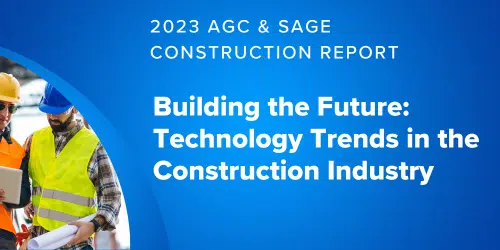Building the Future: Emerging Construction Technology Trends

Key Findings from the 2023 AGC and Sage Construction Business Outlook
Every year, the Associated General Contractors of America (AGC), in partnership with Sage, conducts a comprehensive survey of contractors from across the United States. This survey, known as the 2023 Construction Hiring and Business Outlook, serves as a valuable resource for understanding and analyzing the construction technology trends that are shaping the construction industry.
The latest survey results reveal some key insights into the industry’s outlook for the year ahead. Overall, contractors are optimistic about the future, buoyed by the expectation of increased public sector funding. This optimism is in part due to the shifting work and shopping patterns brought on by the pandemic, as well as the government’s commitment to investing in infrastructure.
Stephen E. Sandherr, AGC’s chief executive officer, highlighted the significance of these findings, stating, “Contractors are optimistic about the construction outlook for 2023, yet they are expecting very different market conditions for the coming year than what they experienced last year.” He also emphasized that despite the evolving market demand, contractors will continue to face ongoing challenges such as supply chain issues and labor shortages, which have been prominent concerns in the industry throughout 2022.
These survey findings offer valuable insights into the current state of the construction industry and provide a glimpse into what contractors can expect in the year ahead. By understanding these trends and challenges, industry professionals can better navigate the changing landscape and position themselves for success.
Strategic IT planning
As the industry navigates numerous challenges, including the shortage of qualified workers and supply chain issues, the importance of technology in connecting teams and enhancing business visibility and efficiency cannot be overstated. In response to these challenges, firms have become increasingly strategic in their approach to IT over the past few years. A significant 61 percent of firms now have a formal IT plan in place to support their business objectives. Looking ahead, an additional 8 percent of firms have plans to adopt a formal IT plan by 2023. These figures closely mirror the findings from last year, indicating a consistent trend in the industry’s focus on IT planning and implementation.
Technology Investment Levels
Similar to the findings of the 2022 survey, most firms intend to maintain their technology investment at the same level as the previous year. When respondents were asked about their plans regarding increasing or decreasing investment, or keeping it the same, in 15 different types of technologies, the majority (ranging from 68 to 91 percent) expressed their intention to maintain the same investment as the previous year across all technologies. Looking specifically at plans for increased technology spending in 2023, it is noted that approximately a quarter to a third of firms plan to increase their investments in various technologies.
One notable category with a significant increase in spending is document management software, with nearly one-third of respondents planning to allocate more funds in this area. Project management software closely follows, with 30 percent of firms indicating their intent to increase spending in this domain. Additionally, approximately one-fourth of firms plan to enhance their investments in accounting software, estimating software, tool and asset management or tracking, and human resources software. It is worth mentioning that only a small percentage (1-2 percent) of respondents expect to decrease investment in any of the 15 technologies. These figures align closely with the numbers recorded in the previous year, indicating consistent construction technology trends in investment patterns.
Overall, these findings highlight the intention of firms to maintain their technology investment levels and focus on specific areas for potential growth and improvement in the coming year.
Cloud-based and Mobile Technology
As construction firms seek more flexibility and anytime, anywhere access from their solutions, we have seen more firms turning to cloud-based technologies the past few years. The most prevalent use of cloud-hosted technology is in project management, with 57 percent of firms using it. Nearly half (47 percent) of contractors use cloud technology for field operations, while 45 percent use cloud technology for accounting, and 42 percent use cloud technology for time tracking. Only 16 percent use cloud technology for tool management, while 21 percent say they do not use the cloud. While we saw some gains in these percentages in last year’s survey, this year’s numbers closely matched those in the 2022 survey.
As we’ve seen in previous years, when it comes to the use of mobile software technology, the adoption numbers are higher. According to these construction technology trends, more than two-thirds (68 percent) of firms are using mobile software for daily field reports, while 61 percent will use mobile technology for employee time tracking and approval. More than half plan to use mobile software technology for the sharing of drawings, photos, and documents (58 percent, up 3 points from last year) and access to customer and job information from the field (56 percent). These numbers were all in line with last year’s findings.
Top IT Challenges
While technology brings a myriad of benefits, firms often face several IT challenges in its implementation. In recent years, the primary challenge has been finding the necessary time to effectively implement and train employees on new technologies, with 40 percent of firms identifying it as their top concern. Additionally, 38 percent of firms have encountered resistance from employees towards adopting new technology, highlighting the need for change management strategies. Ensuring the security of company data from potential hackers remains a prominent challenge, as indicated by 37 percent of firms. Furthermore, connectivity to remote job sites has emerged as a critical challenge for 35 percent of organizations, emphasizing the importance of robust network infrastructure.
Although these percentages closely align with last year’s responses, two challenges have witnessed an increase in mentions compared to the 2022 survey. Integration between various software systems used within a company is now considered a top challenge by 32 percent of firms, reflecting the need for seamless data flow and interoperability. Similarly, 27 percent of organizations have recognized the importance of keeping software current to meet evolving business requirements, representing a 5-point increase from the previous year. These construction technology trends highlight the dynamic nature of IT challenges and the continuous effort required to address them effectively.
Embracing Cloud-Based Technologies
In the current market conditions, technology will continue to play an integral role for contractors who strive to achieve more with less. The challenges they face can be effectively addressed by leveraging cloud-based technology, especially solutions that offer an open API. These advanced technologies are not only easy to integrate with existing business software but also ensure smooth collaboration with external stakeholders. With automatic updates, businesses can stay up-to-date with the latest features, while benefiting from enhanced connectivity and robust security measures.
As a result, more and more businesses are embracing cloud solutions once they overcome the initial hurdle of finding time to implement and train on new technology. To make this transition less overwhelming, contractors can start by focusing on technology with the most immediate impact, gradually implementing new solutions in stages, ensuring an efficient adoption process.
When it comes to construction technology it’s important to work with a company that knows how general contractors and other construction companies do business. As a trusted Sage partner, MicroAccounting has the experience to build the infrastructure your team needs for more effective financial and project management, pre-construction, and field operations, regardless of your size or specialization. Contact us for a personalized Sage Intacct Construction demo.




